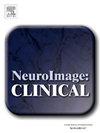Characterising grey-white matter relationships in recent-onset psychosis and its association with cognitive function
IF 3.6
2区 医学
Q2 NEUROIMAGING
引用次数: 0
Abstract
Individuals with recent-onset psychosis (ROP) present widespread grey matter (GM) reductions and white matter (WM) abnormalities. While prior studies used univariate approaches, understanding how multiple GM regions relate to WM tracts is important, as psychosis involves network-level brain dysfunction. Understanding characteristic GM-WM patterns may also clarify the basis of cognitive impairments, which are potentially linked to network dysfunction in psychosis. Using multivariate analysis, we examined whole-brain GM-WM relationships and their association with cognitive abilities in ROP.
We used T1 and diffusion-weighted images from 71 non-affective ROP individuals (age 22.09 ± 3.08) and 71 matched controls (age 22.05 ± 3.21). We performed multiblock partial least squares correlation (MB-PLS-C) to identify GM-WM patterns based on GM thickness or surface area and WM fractional anisotropy (FA), and examined their associations with cognitive abilities.
MB-PLS-C identified a ‘GM thickness’–‘WM FA’ pattern representing group differences, explaining 12.38 % of the variance and associated with frontal and temporal GM regions and seven WM tracts around subcortical structures. MB-PLS-C also identified a ‘GM surface area’–‘WM FA’ pattern showing group differences, explaining 18.92 % and related with cingulate, frontal, temporal, and parietal GM regions and 15 WM tracts, including the inferior cerebellar peduncle and corona radiata. The ‘GM thickness’–‘WM FA’ pattern describing group differences was significantly correlated with processing speed in ROP.
MB-PLS-C identified differential whole-brain GM-WM relationships, indicating a potential signature of brain alterations in ROP. Our findings of a relationship between processing speed and GM-WM patterns for GM thickness have implications for our understanding of brain-behaviour relationships in psychosis.
新发精神病的灰质-白质关系特征及其与认知功能的关系
新近发病的精神病(ROP)个体表现为广泛的灰质(GM)减少和白质(WM)异常。虽然先前的研究使用单变量方法,但了解多个GM区域如何与WM束相关是很重要的,因为精神病涉及网络水平的脑功能障碍。了解典型的GM-WM模式也可以澄清认知障碍的基础,这可能与精神病中的网络功能障碍有关。使用多变量分析,我们检查了全脑GM-WM关系及其与ROP认知能力的关系。我们使用了71例非情感性ROP个体(年龄22.09 ± 3.08)和71例匹配对照(年龄22.05 ± 3.21)的T1和弥散加权图像。我们采用多块偏最小二乘相关(MB-PLS-C)来识别基于GM厚度或表面积和WM分数各向异性(FA)的GM-WM模式,并研究它们与认知能力的关系。MB-PLS-C鉴定出“GM厚度”-“WM FA”模式代表了组间差异,解释了12.38% %的方差,并与额叶和颞叶GM区域以及皮层下结构周围的7个WM束相关。MB-PLS-C还发现了“GM表面积”-“WM FA”模式,显示了组间差异,解释了18.92% %,与扣带、额叶、颞叶和顶叶GM区域和15个WM束有关,包括小脑下脚和辐射冠。描述组间差异的“GM厚度”-“WM FA”模式与ROP的处理速度显著相关。MB-PLS-C鉴定出全脑GM-WM的差异关系,表明ROP中大脑改变的潜在特征。我们发现处理速度和GM- wm模式之间的关系对于我们理解精神病的大脑行为关系具有重要意义。
本文章由计算机程序翻译,如有差异,请以英文原文为准。
求助全文
约1分钟内获得全文
求助全文
来源期刊

Neuroimage-Clinical
NEUROIMAGING-
CiteScore
7.50
自引率
4.80%
发文量
368
审稿时长
52 days
期刊介绍:
NeuroImage: Clinical, a journal of diseases, disorders and syndromes involving the Nervous System, provides a vehicle for communicating important advances in the study of abnormal structure-function relationships of the human nervous system based on imaging.
The focus of NeuroImage: Clinical is on defining changes to the brain associated with primary neurologic and psychiatric diseases and disorders of the nervous system as well as behavioral syndromes and developmental conditions. The main criterion for judging papers is the extent of scientific advancement in the understanding of the pathophysiologic mechanisms of diseases and disorders, in identification of functional models that link clinical signs and symptoms with brain function and in the creation of image based tools applicable to a broad range of clinical needs including diagnosis, monitoring and tracking of illness, predicting therapeutic response and development of new treatments. Papers dealing with structure and function in animal models will also be considered if they reveal mechanisms that can be readily translated to human conditions.
 求助内容:
求助内容: 应助结果提醒方式:
应助结果提醒方式:


